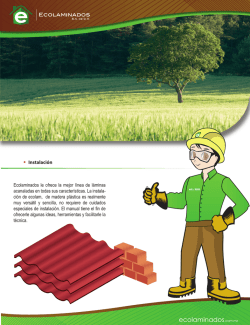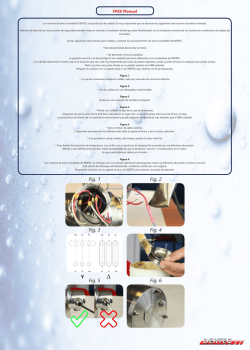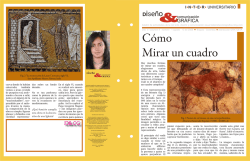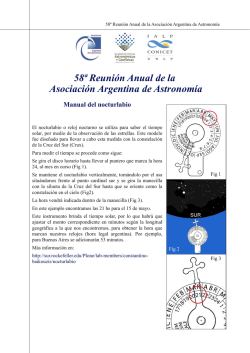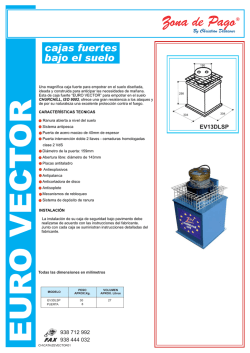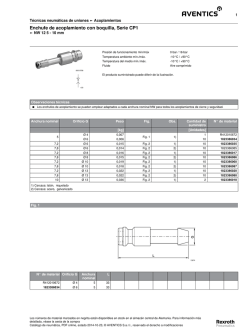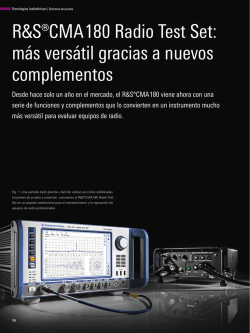
PDF, 3.8 MB - Instituto de Biología
Available online at www.sciencedirect.com Revista Mexicana de Biodiversidad Revista Mexicana de Biodiversidad 86 (2015) 281–292 www.ib.unam.mx/revista/ Taxonomy and systematics First record of benthic diatoms (Bacillariophyceae and Fragilariophyceae) from Isla Guadalupe, Baja California, Mexico Primer registro de diatomeas bentónicas (Bacillariophyceae y Fragilariophyceae) de isla Guadalupe, Baja California, México Francisco Omar López-Fuerte a , David A. Siqueiros-Beltrones b,∗ , Ricardo Yabur c a Laboratorio de Sistemas Arrecifales, Departamento Académico de Economía, Universidad Autónoma de Baja California Sur, Carretera al Sur, Km. 5.5, 23080 La Paz, B.C.S., Mexico b Departamento de Plancton y Ecología Marina, Centro Interdisciplinario de Ciencias Marinas, Intituto Politécnico Nacional, Av. Instituto Politécnico Nacional s/n, Col. Playa Palo de Santa Rita, 23096 La Paz, B.C.S., Mexico c Departamento Académico de Biología Marina, Universidad Autónoma de Baja California Sur, Carretera al Sur, Km. 5.5, 23080 La Paz, B.C.S., Mexico Received 13 June 2014; accepted 3 December 2014 Available online 26 May 2015 Abstract Guadalupe Island represents a unique ecosystem. Its volcanic origin and remoteness from the Baja California peninsula have allowed for the successful establishment of its distinctive flora and fauna. However, the difficulty in accessing the island has precluded the study of its biotic communities, mainly the marine ones. Consequently, no studies on benthic or planktonic diatoms have been hitherto published. Thus, the first records of marine benthic diatom species (epiphytic, epilithic, epizoic) from Guadalupe Island in the NW Mexican Pacific are here provided. One hundred and nineteen diatom taxa belonging to the Bacillariophyceae and Fragilariophyceae were identified, including species and varieties. The former with 87 taxa was the most diverse. Thirteen taxa are new records for Mexico; photographic images of these are provided. Because this is the first study for the benthic diatoms of Isla Guadalupe, a particular bio-geographical affinity is not proposed. However, the best represented genus was Mastogloia which has tropical affinity, and Cocconeis thalassiana was also identified, a new species recently recorded for the Mexican Caribbean. All Rights Reserved © 2015 Universidad Nacional Autónoma de México, Instituto de Biología. This is an open access item distributed under the Creative Commons CC License BY-NC-ND 4.0. Keywords: Insular; Bacillariophyta; Epiphytic; Epilithic; Epizoic; Eastern Pacific Resumen Isla Guadalupe es única como ecosistema; su origen volcánico y lejanía de la península de Baja California han permitido que el desarrollo evolutivo de sus distintivas flora y fauna haya sido exitoso. La dificultad para acceder a la isla es causa de que algunas comunidades, principalmente marinas, no hayan sido estudiadas aún. Consecuentemente, a la fecha no existía algún estudio publicado sobre diatomeas. Así, se presenta el primer registro de diatomeas bentónicas (epilíticas, epifitas y epizoicas) de isla Guadalupe en el noroeste de México. Se identificaron 119 taxa (incluyendo especies y variedades) de diatomeas pertenecientes a las clases Bacillariophyceae y Fragilariophyceae. Las primeras fueron más diversas con 87 taxa. Del total, 13 taxa son nuevos registros para México y se proveen imágenes fotográficas de ellos. Dado que se trata apenas del primer estudio para la flora de diatomeas bentónicas de isla Guadalupe, no se propone una afinidad biogeográfica. Sin embargo, uno de los géneros con mayor número de especies es de afinidad tropical, i.e., Mastogloia y se identificó Cocconeis thalassiana, una especie nueva recientemente registrada para el Caribe mexicano. Derechos Reservados © 2015 Universidad Nacional Autónoma de México, Instituto de Biología. Este es un artículo de acceso abierto distribuido bajo los términos de la Licencia Creative Commons CC BY-NC-ND 4.0. Palabras clave: Insular; Bacillariophyta; Epifitas; Epilíticas; Epizoicas; Pacífico oriental ∗ Corresponding author. E-mail address: [email protected] (D.A. Siqueiros-Beltrones). Peer Review under the responsibility of Universidad Nacional Autónoma de México. http://dx.doi.org/10.1016/j.rmb.2015.04.016 1870-3453/All Rights Reserved © 2015 Universidad Nacional Autónoma de México, Instituto de Biología. This is an open access item distributed under the Creative Commons CC License BY-NC-ND 4.0. 282 F.O. López-Fuerte et al. / Revista Mexicana de Biodiversidad 86 (2015) 281–292 Introduction describes assemblages of epipelic diatoms characteristic of mangrove environments (López-Fuerte, Siqueiros-Beltrones, & Navarro, 2010). In this study we begin the construction of a taxonomic basis that serves for monitoring and assessing the environmental health of any ecosystem, and provide the first floristic account of benthic diatoms from Isla Guadalupe. Isla Guadalupe is a natural reserve that represents a unique ecosystem as other Mexican islands. Its volcanic origin and distance from the Baja California peninsula have allowed for a successful evolutionary development of both its particular land and marine flora and fauna, as can be inferred by the high number of cases of endemism recorded (Aguirre-Muñoz et al., 2003; García-Gutiérrez et al., 2005). However, studies on biodiversity, particularly of marine life, are lacking for Isla Guadalupe, mainly because of the difficulty to access the island. The available studies on marine flora of Isla Guadalupe date back to the late 1800s and were published by Setchell and Gardner (1930) in a list that included 90 species of macroalgae. The last review of the macroalgae of Isla Guadalupe was carried out by Stewart and Stewart (1984) and included 212 species, with 24 new records. Both studies recorded a large number of genera of subtropical affinity, indicating that the marine flora in the island is more characteristic of a subtropical than a temperate environment. The difficulty in accessing an area such as Isla Guadalupe to carry out scientific research is the main cause that many marine communities are yet to be studied, even in their most basic aspects such as species composition. Thus, no published work existed hitherto on diatoms from that area, nor planktonic or benthic forms, in spite of being the most diverse, abundant and productive algal group in marine ecosystems. In general, studies on benthic diatoms from the Mexican NW are scarce, and these are related either with their role in the feeding habits of abalone (Haliotis spp.) and grazing intertidal molluscs (Siqueiros-Beltrones & ValenzuelaRomero, 2004), or the structure of epiphytic forms assemblages found on macroalgae and marine plants (Argumedo-Hernández & Siqueiros-Beltrones, 2008; Siqueiros-Beltrones, ServiereZaragoza, & Argumedo-Hernández, 2002). Another study Materials and methods Isla Guadalupe is located in the Mexican Pacific Ocean approximately 256 km off the coast of the Baja California peninsula at 29◦ N, 118◦ W, within the Guadalupe Island Biosphere Reserve (Fig. 1). It is influenced by the California Current which is characterized by low temperature and salinity (Lynn & Simpson, 1987). Surficial water temperature ranges between 15 and 20 ◦ C during winter and between 20 and 22 ◦ C in summer. Its ocean volcanic nature and its remote distance from the coast confer it an abrupt topography and a unique biodiversity. The coastal zone physiography consists of loose basalts, blocks, dikes, cliffs, and few sandy beaches (Pierson, 1987). Sample collection Surficial temperature, salinity and pH were measured in situ using a field multi-sensor (Horiba U10). Benthic diatoms were collected at Guadalupe Island in one sampling site on January 18, 2013. Epiphytic diatoms were scraped off from specimens of Eisenia desmarestioides Setchell and N.L. Gardner, 1930 (Ochrophyta; Laminariales), and Codium latum subsp. palmeri (E.Y. Dawson) P.C. Silva, 1962 (Chlorophyta; Bryopsidales), using a glass slide for each sampling. Epilithic and epizoic diatoms from the shell of the sea-snail Megastraea undosa 118º10’0’’W 29º10’0’’N 118º20’0’’W N EI Chango 29º0’0’’N Guadalupe Island Campo Oeste La Proa 28º50’0’’N EI Toro USA BC 28º40’0’’N Mexico Pacific Ocean BCS 0 250 500 Figure 1. Location of Isla Guadalupe and sampling site. 750 1,000 km F.O. López-Fuerte et al. / Revista Mexicana de Biodiversidad 86 (2015) 281–292 W. Wood, 1828 were brushed off from an area of 5 cm2 in each substrate using a toothbrush. Afterwards, a compound sample was formed for the site and preserved in commercial ethanol (70%); concomitant observations of fresh diatom samples were made. In order to clean the diatom frustules for identification the organic matter was oxidized with a mixture of sample, commercial ethanol and nitric acid at a 1:3:5 proportion (Siqueiros-Beltrones, 2002). The samples were then rinsed with drinking water until reaching a pH >6. From each compound 283 sample three permanent slides were mounted for each substrate using Zrax® (RI: 1.7) as mounting medium. All species names and authorities were revised, and in certain cases nomenclatural updates were made, confirming all of the currently accepted taxonomic names. In order to revise the taxonomic names and their synonymies, we consulted Round, Crawford, and Mann (1990) along with the data bases on www.algaebase.org (Guiry & Guiry, 2014) and www.marinespecies.org (WoRMS Editorial Board, 2014). Taxonomic keys used for species identification Figures 2–9. Iconographic sample of the diatoms observed on different coastal substrata from Isla Guadalupe. All images by Folf. Bar = 10 m. (2) Campylodiscus crebrecostatus var. speciosa, (3) Campylodiscus ambiguus, (4) Campylodiscus fastuosus, (5) Podocystis adriatica, (6) Campyloneis grevillei, (7) Lyrella approximata, (8) Mastogloia fimbriata, (9) Surirella fastuosa. 284 F.O. López-Fuerte et al. / Revista Mexicana de Biodiversidad 86 (2015) 281–292 included: Schmidt et al. (1874–1959), Peragallo and Peragallo (1897–1908), Foged (1984), Witkowski, Lange-Bertalot, and Metzeltin (2000), Siqueiros-Beltrones (2002), and LópezFuerte et al. (2010). Photographic images of newly recorded taxa and others were acquired using an electronic ocular lens. Results Surficial water temperature in the sampling site was measured at 17.7 ◦ C; salinity was recorded at 38 psu, which renders the environment as polyhalobous. The measured pH was close to neutral at 7.4. Figures 10–19. 10) Girdle view, (11) Rhabdonema adriaticum, (12 and 13) Rhabdonema arcuatum, (14) Diploneis bombus, (15) Girdle view, (16) Climacosphenia moniligera, (17) Alveus marinus, (18) Amphiprora conspicua, (19) Gephyria media. F.O. López-Fuerte et al. / Revista Mexicana de Biodiversidad 86 (2015) 281–292 285 Figures 20–34. (20) Licmophora abbreviata, (21) Grammatophora marina, (22) Grammatophora undulata, (23) Campylopyxis garkeana, (24) Trachyneis aspera, (25) Brachysira aff. neoexilis, (26) Denticula kuetzingii, (27) Plagiodiscus nervatus, (28) Licmophora communis, (29) Licmophora ehrenbergii, (30) Licmosoma squamosum, (31) Psammodiscus calceatus, (32) Cocconeis molesta var. crucifera, (33) Diploneis suborbicularis var. constricta, (34) Diploneis coffaeiformis. 286 F.O. López-Fuerte et al. / Revista Mexicana de Biodiversidad 86 (2015) 281–292 Figures 35–44. (35) Donkinia reticulata, (36) Striatella unipunctata, (37) Parlibellus delognei, (38 and 42) Mastogloia ciskeiensis, (39) Lyrella perplexoides, (40) Achnanthes citronella, (41) Amphora proteus var. oculata, (43) Mastogloia asperuloides, (44) Mastogloia punctatissima. F.O. López-Fuerte et al. / Revista Mexicana de Biodiversidad 86 (2015) 281–292 Floristic analysis yielded 119 taxa including species and varieties of benthic diatoms, including epiphytic, epilithic and epizoic forms (Appendix). All diatoms appear alive in the fresh mountings (Fig. 2). The class Bacillariophyceae with 87 taxa was much more diverse than the Fragilariophyceae which yielded 32 taxa. Out of the 45 identified genera, those with higher number of species were Mastogloia (13), Diploneis (11 species), Nitzschia (10), Cocconeis (9), Grammatophora (6) and Licmophora (5). These represent 46% of the species recorded in this study. In contrast, 25 genera were represented by a single species. Thirteen taxa are new records for Mexico: Achnanthes citronella (A. Mann) Hustedt (Fig. 40), Amphiprora conspicua Greville (Fig. 18), Amphora proteus var. oculata H. Peragallo (Fig. 41), Campylodiscus ambiguus Greville (Fig. 3), Diploneis coffaeiformis (Schmidt) Cleve (Fig. 34), D. suborbicularis var. constricta Hustedt (Fig. 33), Donkinia reticulata Norm. (Fig. 35), Lyrella perplexoides (Hustedt) D.G. Mann (Fig. 39), Mastogloia asperuloides Hustedt (Fig. 43), M. ciskeiensis Giffen (Figs. 38 and 42), M. punctatissima (Greville) Ricard (Fig. 44), Parlibellus delognei (Van Heurck) E. J. Cox (Fig. 37) and Psammodiscus calceatus T. Watanabe, T. Nagumo and J. Tanaka (Fig. 31). Only 11 taxa occurred in all three surveyed substrates. The higher number of taxa was observed on the rocky substrate (57), and the lowest on the shell of Megastraea undosa. On the other hand, the higher number of exclusive taxa occurred on macroalgal substrate, particularly on Eisenia desmarestioides with 29 taxa, which renders it as a proper substrate for diatoms, while M. undosa had the lowest (6) number of taxa. Discussion Research on benthic marine diatoms in Mexico dates barely to the 1980s, and most studies have been carried out for the NW region. Recently, however, some have been carried out in the Mexican Caribbean area (Hernández-Almeida, HerreraSilveira, & Merino-Virgilio, 2013; López-Fuerte, SiqueirosBeltrones, & Hernández-Almeida, 2013; Siqueiros-Beltrones, Argumedo-Hernández, & Hernández-Almeida, 2013). Nonetheless, there are still extensive areas in the country where the most basic floristic studies on benthic diatoms are lacking and are badly needed. Our present work falls within this category, inasmuch no research on diatoms, whether scientific or of any sort, existed for Mexican islands, in spite the fact that 1365 islands are distributed within the Mexican territory (Comité Asesor Nacional sobre el Territorio Insular Mexicano, 2012). Thus, this constitutes the first floristic list of benthic diatoms for any oceanic island located in the exclusive economic zone of Mexico, and it targets the Guadalupe Island Biosphere Reserve. Although only three substrates were examined, the number of identified taxa is high, and over 11% are new records for the whole country. Some of the genera with a higher number of species are of tropical affinity, e.g., Mastogloia. 287 Others such as Cocconeis thalassiana, primarily described for the Mexican Caribbean (Romero & López-Fuerte, 2013), leads us to suggest that, as with the terrestrial flora, Isla Guadalupe does not have a diatom flora with a particular biogeographical affinity, i.e., temperate, subtropical, or tropical. Moreover, due to the distance of the island with the continent it is likely that further observations based on a more exhaustive sampling may render new records of diatom species or varieties. This, and on the basis that Isla Guadalupe is not influenced by coastal upwelling, shows a biogeographically mixed macroalgal flora that includes species from California, the Mexican tropics, and the insular Indo-Pacific, plus a conspicuous group of endemic taxa derived from the California flora. All of these are evidence of their effective isolation and the ecological divergence in a process of speciation (Dawson, 1960). In comparison with E. desmarestioides that stands out as a proper substrate for diatoms with 29 exclusive taxa and the second most number of taxa overall, Siqueiros-Beltrones et al. (2002) did not find diatom epiphytes on Eisenia arborea Areschoug, although recent research has shown that older blades may harbor monospecific proliferations of diatoms. Along the West coast of the Baja California Peninsula, Macrocystis pyrifera (Linnaeus) C. Agardh is considered the main food source of abalone (Haliotis spp.), together with its numerous epiphytic diatom species (Argumedo-Hernández & SiqueirosBeltrones, 2008). However, in Isla Guadalupe M. pyrifera is absent, thus its ecological role may be replaced by E. desmarestioides, which is the largest macroalgae in the area and, according to the local fishermen, its abundance relate to the that of abalone. Aside from this being the first publication on the diatom flora of Isla Guadalupe or any other Mexican island, the high number of new records either for the region or the whole country gives an insight to a highly diverse flora hitherto unknown as an assemblage. Thus, the generated information is relevant both in bio-geographical as well as in environmental health terms. We are confident that further exhaustive research will provide much valuable information that is hard to come by, given the remoteness of the studied area. The differential distribution of exclusive diatom taxa on distinct substrates strongly supports the expectation of increasing the species richness for the island as more substrates are examined. Acknowledgements This study was financed by the Comisión Nacional para el Conocimiento y Uso de la Biodiversidad, through project Conabio-JF170. Conanp permit, Folio No: F00.DRPBCPN.000025. Semarnat notice, Folio No. SGPA/DGVS/05604/12. Sagarpa permit, Folio No. PPF/DGOPA-215/2013. We thank the Semar and Cooperativa de abuloneros y langosteros de isla Guadalupe for maritime transportation. The second author is EDI and COFAA fellow of the IPN. 288 F.O. López-Fuerte et al. / Revista Mexicana de Biodiversidad 86 (2015) 281–292 Appendix. List of benthic diatoms recorded for the Biosphere Reserve Isla Guadalupe, Mexico. Symbols indicate the type of substrate from which it was sampled. Epiphytic (Eisenia desmarestioides *; Codium latum subsp. palmeri ); epilithic 䊉 ; epizoic (Megastraea undosa); new records for Mexico. Class Bacillariophyceae Haeckel, 1878 Subclass: Bacillariophycidae D.G. Mann, 1990 Order: Achnanthales Silva, 1962 Family: Achnanthaceae Kützing, 1844 Achnanthes Bory de Saint Vincent, 1822 1. Achnanthes brevipes var. angustata (Greville) Cleve, 1894 2. Achnanthes brevipes var. intermedia (Kützing) Cleve, 1895 3. Achnanthes citronella (A. Mann) Hustedt, 1937 4. Achnanthes yaquinensis McIntire et Reimer, 1974 Order: Bacillariales Hendey, 1937 Family: Bacillariaceae Ehrenberg, 1831 Alveus Kaczmarska et Fryxell, 1995 5. Alveus marinus (Grunow) Kaczmarska et Fryxell, 1996 (Fig. 17) Denticula Kützing, 1844 6. Denticula kuetzingii Grunow, 1862 (Fig. 26) Nitzschia Hassall, 1845 7. Nitzschia angularis W. Smith, 1853 8. Nitzschia dissipata (Kützing) Grunow, 1862 9. Nitzschia macilenta W. Gregory, 1859 10. Nitzschia marginulata var. didyma Grunow, 1880 11. Nitzschia punctata var. coarctata (Grunow) Hustedt, 1921 12. Nitzschia sigma (Kützing) W. Smith, 1853 13. Nitzschia spathulata W. Smith, 1853 14. Nitzschia tryblionella Hantzsch, 1860 15. Nitzschia ventricosa Kitton, 1873 Tryblionella W. Smith, 1853 16. Tryblionella hungarica (Grunow) Frenguelli, 1942 Order: Cymbellales D.G. Mann, 1990 Family: Rhoicospheniaceae Chen et Zhu, 1983 Campylopyxis L. K. Medlin, 1985 17. Campylopyxis garkeana (Grunow) L. K. Medlin, 1985 (Fig. 23) Gomphonemopsis L.K. Medlin, 1986 18. Gomphonemopsis pseudexigua cf. (R. Simonsen) L.K. Medlin, 1986 Order: Lyrellales D.G. Mann, 1990 Family: Lyrellaceae D.G. Mann, 1990 Lyrella Karajeva, 1978 19. Lyrella approximata (Greville) D.G. Mann, 1990 (Fig. 7) 20. Lyrella perplexoides (Hustedt) D.G. Mann, 1990 Order: Mastogloiales D.G. Mann, 1990 Family: Mastogloiaceae Mereschkowsky, 1903 Mastogloia Thwaites ex W. Smith, 1856 21. Mastogloia asperuloides Hustedt, 1933 22. Mastogloia binotata (Grunow) Cleve, 1895 23. Mastogloia borneensis Hustedt, 1927 24. Mastogloia ciskeiensis Giffen, 1967 25. Mastogloia crucicula (Grunow) Cleve, 1895 26. Mastogloia crucicula var. alternans Zanon, 1948 27. Mastogloia erythraea Grunow, 1860 28. Mastogloia fimbriata (T. Brightwell) Grunow, 1863 (Fig. 8) 29. Mastogloia gieskesii Cholnoky, 1963 30. Mastogloia mediterranea Hustedt, 1933 31. Mastogloia obliqua Hagelstein, 1939 32. Mastogloia punctatissima (Greville) Ricard, 1975 33. Mastogloia rostrata (Wallich) Hustedt, 1933 Order: Naviculales Bessey, 1907 Family: Amphipleuraceae Grunow, 1862 Amphiprora Ehrenberg, 1844 34. Amphiprora conspicua Greville, 1861 (Fig. 18) Family: Brachysiraceae D. G. Mann, 1990 Brachysira Kützing, 1836 35. Brachysira aff. neoexilis Lange-Bertalot, 1994 (Fig. 25) 䊉 䊉 䊉 䊉 䊉 䊉 * * * * 䊉 * 䊉 * * * * 䊉 䊉 䊉 * * 䊉 䊉 䊉 䊉 䊉 䊉 * * * 䊉 䊉 F.O. López-Fuerte et al. / Revista Mexicana de Biodiversidad 86 (2015) 281–292 289 Appendix (Continued) Family: Pinnulariaceae D.G. Mann, 1990 Oestrupia Heiden ex Hustedt, 1935 36. Oestrupia musca (Gregory) Hustedt, 1935 Suborder: Diploneidineae D.G. Mann, 1990 Family: Diploneidaceae D.G. Mann, 1990 Diploneis Ehrenb. ex Cleve, 1844 37. Diploneis aestuarii Hustedt, 1939 38. Diploneis bombus (Ehrenb.) Ehrenberg, 1853 (Fig. 14) 39. Diploneis chersonensis (Grunow) Cleve, 1894 40. Diploneis coffaeiformis (Schmidt) Cleve, 1894 41. Diploneis crabro (Ehrenb.) Ehrenberg, 1854 42. Diploneis nitescens (Gregory) Cleve, 1894 43. Diploneis papula (A.W.F. Schmidt) Cleve, 1894 44. Diploneis papula var. constricta Hustedt, 1937 45. Diploneis suborbicularis var. constricta Hustedt, 1937 46. Diploneis vacillans var. renitens (A. Schmidt) Cleve, 1894 47. Diploneis vacillans var. vacillans (A. Schmidt) Cleve, 1894 Suborder: Naviculineae (Bessey) Hendey, 1937 Family: Naviculaceae Kützing, 1844 Caloneis Cleve, 1894 48. Caloneis excentrica (Grunow) Boyer, 1927 49. Caloneis linearis (Grunow) Boyer, 1927 Navicula Bory de Saint-Vincent, 1822 50. Navicula agnita Hustedt,1955 51. Navicula cancellata Donkin, 1872 52. Navicula longa var. irregularis Hustedt, 1955 53. Navicula zostereti Grunow, 1860 Trachyneis Cleve, 1894 54. Trachyneis aspera (Ehrenb.) P.T. Cleve, 1894 (Fig. 24) 55. Trachyneis velata A. Schmidt, 1876 Family: Pleurosigmataceae Mereschkowsky, 1903 Pleurosigma W. Smith, 1852 56. Pleurosigma salinarum (Grunow) Grunow, 1880 Family: Sellaphoraceae Mereschkowsky, 1902 Fallacia Stickle et D.G. Mann, 1990 57. Fallacia forcipata (Greville) Stickle et Mann, 1990 Family: Berkeleyaceae D.G. Mann, 1990 Parlibellus E. J. Cox, 1998 58. Parlibellus delognei (Van Heurck) E. J. Cox, 1988 Family: Pleurosigmataceae Mereschkowsky, 1903 Donkinia Ralfs, 1861 59. Donkinia reticulata Norman, 1861 Order: Rhopalodiales D.G. Mann, 1990 Family: Rhopalodiaceae (G. Karst.) Topachevs’kyj et Oksiyuk, 1960 Rhopalodia Otto Müll., 1895 60. Rhopalodia pacifica Krammer, 1987 Epithemia Kützing, 1844 61. Epithemia turgida (Ehrenb.) Kützing, 1844 Order: Surirellales D. G. Mann, 1990 Family: Surirellaceae Kützing, 1844 Campylodiscus Ehrenb. ex Kützing, 1840 62. Campylodiscus ambiguus Greville, 1860 63. Campylodiscus crebrecostatus var. speciosa T. Eulenstein, 1875 (Fig. 2) 64. Campylodiscus fastuosus Ehrenberg, 1845 (Fig. 4) 65. Campylodiscus simulans Gregory, 1857 Family: Cocconeidaceae Kützing, 1844 Campyloneis Grunow, 1862 66. Campyloneis grevillei Petit, 1877 (Fig. 7) Cocconeis Ehrenberg, 1836 67. Cocconeis costata var. hexagona Grunow, 1880 68. Cocconeis dirupta var. flexella (Janisch et Rabenhorst) Grunow, 1880 69. Cocconeis discrepans A.W.F. Schmidt, 1894 70. Cocconeis molesta var. crucifera Grunow, 1880 (Fig. 32) 71. Cocconeis molesta var. molesta Kützing, 1844 72. Cocconeis pediculus Ehrenberg, 1838 73. Cocconeis cf. pseudomarginata Gregory, 1857 + * * * * * * * 䊉 䊉 䊉 䊉 䊉 * * * * * 䊉 䊉 * * * * * 䊉 䊉 䊉 䊉 䊉 䊉 䊉 䊉 * 䊉 290 F.O. López-Fuerte et al. / Revista Mexicana de Biodiversidad 86 (2015) 281–292 Appendix (Continued) 74. Cocconeis scutellum Ehrenberg, 1838 75. Cocconeis thalassiana O.E. Romero et F.O. López-Fuerte, 2013 Psammodictyon D.G. Mann, 1990 76. Psammodictyon panduriforme (W. Gregory) D.G. Mann, 1990 Order: Thalassiophysales D.G. Mann, 1990 Family: Catenulaceae Mereschkowsky, 1902 Amphora Ehrenb. ex Kützing, 1844 77. Amphora angusta Gregory, 1857 78. Amphora clevei Grunow, 1875 79. Amphora immarginata Nagumo, 2003 80. Amphora laevissima W. Gregory, 1857 81. Amphora libyca Ehrenberg, 1840 82. Amphora proteus Gregory, 1857 83. Amphora proteus var. oculata H. Peragallo, 1898 84. Amphora rhombica var. intermedia Cleve, 1895 Halamphora (Cleve) Levkov, 2009 85. Halamphora coffeaeformis (C. Agardh) Levkov, 2009 86. Halamphora costata (W. Smith) Levkov, 2009 87. Halamphora cymbifera (Gregory) Levkov, 2009 Class Fragilariophyceae Round et R.M. Crawford, 1990 Order: Climacospheniales Round, 1990 Family: Climacospheniaceae Round, 1990 Climacosphenia Ehrenberg, 1843 88. Climacosphenia moniligera Ehrenberg, 1843 (Figs. 15 and 16) Order: Cyclophorales Round, 1990 Family: Entopylaceae Round, 1990 Gephyria Arnott, 1858 89. Gephyria media Arnott, 1860 (Fig. 19) Subclass Fragilariophycidae Round, 1990 Order: Fragilariales Silva, 1962 Family: Fragilariaceae Greville, 1833 Hyalosynedra D.M. Williams et F.E. Round, 1986 90. Hyalosynedra laevigata (Grunow) D.M. Williams et Round, 1986 Opephora Petit, 1889 91. Opephora schwartzii (Grunow) Petit ex Pelletan, 1889 Podocystis J. W. Bailey, 1854 92. Podocystis adriatica (Kützing) Ralfs, 1861 (Fig. 5) Synedra Ehrenberg, 1830 93. Synedra fulgens (Greville) W. Smith, 1853 94. Synedra parva Kützing, 1844 Tabularia (Kützing) D.M. Williams et Round, 1986 95. Tabularia fasciculata (C. Agardh) D.M. Williams et Round, 1986 Order: Licmophorales Round et R.M. Crawford, 1990 Family: Licmophoraceae Kützing, 1844 Licmophora C. Agardh, 1827 96. Licmophora abbreviata C. Agardh, 1831 (Fig. 20) 97. Licmophora communis (Heiberg) Grunow, 1881 (Fig. 28) 98. Licmophora ehrenbergii (Kützing) Grunow, 1867 (Fig. 29) 99. Licmophora gracilis (Ehrenb.) Grunow, 1867 100. Licmophora paradoxa (Lyngbye) C. Agardh, 1828 Licmosoma Round & C.G. Alexander, 2002: 324 101. Licmosoma squamosum Round & C.G. Alexander, 2002 (Fig. 30) Order: Rhaphoneidales Round, 1990 Family: Psammodiscaceae Round et D.G. Mann, 1990 Psammodiscus Round et D.G. Mann, 1980 102. Psammodiscus calceatus T. Watanabe, T. Nagumo et J. Tanaka, 2013. 103. Psammodiscus nitidus (Gregory) Round et D.G. Mann, 1980 Order: Rhabdonematales Round et R.M. Crawford, 1990 Family: Rhabdonemataceae Round et R.M. Crawford, 1990 Rhabdonema Kützing 1844 104. Rhabdonema adriaticum Kützing, 1844 (Figs. 10 and 11) 105. Rhabdonema arcuatum (Lyngbye) Kützing, 1844 (Figs. 12 and 13) Order: Striatellales Round, 1990 Family: Striatellaceae Kützing, 1844 Grammatophora Ehrenberg, 1840 106. Grammatophora angulosa Ehrenberg, 1841 * * 䊉 䊉 䊉 * 䊉 * 䊉 * 䊉 䊉 * 䊉 * 䊉 * * * * * * * 䊉 䊉 䊉 䊉 䊉 䊉 䊉 * * F.O. López-Fuerte et al. / Revista Mexicana de Biodiversidad 86 (2015) 281–292 291 Appendix (Continued) 107. Grammatophora hamulifera Kützing, 1844 108. Grammatophora marina (Lyngbye) Kützing, 1844 (Fig. 21) 109. Grammatophora oceanica Ehrenberg, 1840 110. Grammatophora oceanica var. macilenta (W. Smith) Grunow, 1862 111. Grammatophora undulata Ehrenberg, 1840 (Fig. 22) Striatella C. Agardh, 1832 112. Striatella interrupta (Ehrenb.) Heiberg, 1863 113. Striatella unipunctata (Lyngbye) C. Agardh, 1832 (Fig. 36) Order: Surirellales D.G. Mann, 1990 Family: Surirellaceae Kützing, 1844 Plagiodiscus Grunow et Eulenstein, 1867 114. Plagiodiscus nervatus Grunow, 1867 (Fig. 27) Surirella Turpin, 1828 115. Surirella armoricana H. Peragallo et M. Peragallo, 1899 116. Surirella fastuosa (Ehrenb.) Ehrenberg, 1843 (Fig. 9) Order: Thalassionematales Round, 1990 Family: Thalassionemataceae Round, 1990 Thalassionema (Grunow) Grunow, 1881 117. Thalassionema frauenfeldii (Grunow) Tempère et Peragallo, 1910 118. Thalassionema nitzschioides (Grunow) Mereschkowsky, 1902 Order: Toxariales Round, 1990 Family: Toxariaceae Round, 1990 Toxarium Bailey, 1854 119. Toxarium undulatum J.W. Bailey, 1854 References Aguirre-Muñoz, A., Bezaury-Creel, J., Carranza, J., Enkerlin-Hoeflich, E., García-Gutiérrez, C., Luna-Mendoza, et al. (2003). Propuesta para el establecimiento del Área Natural Protegida Reserva de la Biosfera de Isla Guadalupe. Ensenada: Grupo de Ecología y Conservación de Islas, A.C. Argumedo-Hernández, U., & Siqueiros-Beltrones, D. A. (2008). Cambios en la estructura de la asociación de diatomeas epífitas de Macrocystis pyrifera (L.) C. Ag. Acta Botanica Mexicana, 82, 43–66. Comité Asesor Nacional sobre el Territorio Insular Mexicano. (2012). Estrategia Nacional para la Conservación y el Desarrollo Sustentable del Territorio Insular Mexicano. México, D.F. y Ensenada, B.C.: Secretaría del Medio Ambiente y Recursos Naturales, Instituto Nacional de Ecología, Comisión Nacional de Áreas Naturales Protegidas, Secretaría de Gobernación, Secretaría de Marina-Armada de México y Grupo de Ecología y Conservación de Islas, A.C. Dawson, E. Y. (1960). Symposium: The biogeography of Baja California and adjacent seas Part II. Marine Biotas. A review of the ecology distribution, and affinities of the benthic flora. Systematic Zoology, 9, 93–100. Foged, N. (1984). Freshwater and littoral diatoms from Cuba. Bibliotheca Diatomologica, Band 5. Berlin: J. Cramer. García-Gutiérrez, C., Hinojosa-Corona, A., Franco-Vizcaíno, E., Riggan, P. J., Bocco, G., Luna-Mendoza, L., et al. (2005). Cartografía base para la conservación de Isla Guadalupe. Avances, perspectivas y necesidades. In K. Santos, & E. Peters (Eds.), Isla Guadalupe, restauración y conservación (pp. 19–25). México, D.F.: Instituto Nacional de Ecología, Semarnat, CICESE, Grupo de Ecología y Conservación de Islas, A.C., Semar. Guiry, M. D., & Guiry, G. M. (2014). AlgaeBase. World-wide electronic publication. Galway: National University of Ireland. Retrieved from: http://www.algaebase.org Hernández-Almeida, O. U., Herrera-Silveira, J. A., & Merino-Virgilio, F. (2013). Nueve nuevos registros de diatomeas bentónicas de los géneros Climaconeis, Cocconeis, Licmophora, Talaroneis, Oestrupia, Petroneis y Synedrosphenia en la costa norte de la Península de Yucatán, México. Hidrobiológica, 23, 154–168. * * * * * 䊉 䊉 䊉 * * 䊉 䊉 䊉 López-Fuerte, F. O., Siqueiros-Beltrones, D. A., & Hernández-Almeida, O. U. (2013). Epiphytic diatoms of Thalassia testudinum in Yalahau lagoon, Quintana Roo, México. Marine Biodiversity Records, 6, 1–11. López-Fuerte, F. O., Siqueiros-Beltrones, D. A., & Navarro, N. (2010). Benthic diatoms associated with mangrove environments in the northwest region of México. México, D.F.: Conabio-UABCS-IPN. Lynn, R. J., & Simpson, J. J. (1987). The California current system: The seasonal variability of its physical characteristics. Journal of Geophysical Research, 92, 12947–12966. Peragallo, H., & Peragallo, M. (1897–1908). Diatomées marines de France et des Districts Maritimes Voisins. Grez-sur-Loing: M. J. Témpere. Pierson, M. O. (1987). Breeding behavior of the Guadalupe fur seal, Arctocephalus townsendi. In J. P. Croxall, & R. L. Gentry (Eds.), Status, biology, and ecology of fur seals. Proceedings of an international symposium and workshop (pp. 23–27). Cambridge: NOAA Tech. Rep. NMFS 51. Romero, O. E., & López-Fuerte, F. O. (2013). Cocconeis thalassiana sp. nov., a new alveolate diatom (Bacillariophyta) from the Mexican Caribbean. Diatom Research, 28, 295–302. Round, F. E., Crawford, R. M., & Mann, D. G. (1990). The diatoms: biology and morphology of the genera. New York: Cambridge University Press. Schmidt, A., Schmidt, M., Fricke, F., Heiden, H., Müller, O., & Hustedt, F. (1874–1959). Atlas der Diatomaceen-kunde. Heft l–120, Tafeln 1–460 (Tafeln 1–216; 213–216; 217–240; 241–244 H. Heiden; 245, 246; 247–256; 257–264; 265–268; 269–472). Aschersleben-Leipzig, Berlin: AkademieVerlag. Setchell, W. A., & Gardner, N. L. (1930). Marine algae of the Revillagigedo Islands Expedition in 1925. Proceedings of the California Academy of Science, Series, 4, 109–215. Siqueiros-Beltrones, D. A. (2002). Diatomeas bentónicas de la Península de Baja California; diversidad y potencial ecológico. La Paz: Oceánides/Cicimar, IPN/UABCS. Siqueiros-Beltrones, D. A., & Valenzuela-Romero, G. (2004). Benthic diatom assemblages in an abalone (Haliotis spp.) habitat in the Baja California Peninsula. Pacific Science, 58, 435–446. Siqueiros-Beltrones, D. A., Argumedo-Hernández, U., & Hernández-Almeida, O. (2013). Diagnosis prospectiva sobre la diversidad de diatomeas epilíticas 292 F.O. López-Fuerte et al. / Revista Mexicana de Biodiversidad 86 (2015) 281–292 en la laguna Bacalar, Quintana Roo, México. Revista Mexicana de Biodiversidad, 84, 865–875. Siqueiros-Beltrones, D. A., Serviere-Zaragoza, E., & Argumedo-Hernández, U. (2002). Epiphytic diatoms of Macrocystis pyrifera (L.) Ag. from the Baja California peninsula. Oceánides, 17, 3–39. Stewart, J. G., & Stewart, J. A. (1984). Algas Marinas de la isla Guadalupe, México, incluyendo una lista de registros. Ciencias Marinas, 10, 135–148. Witkowski, A., Lange-Bertalot, H., & Metzeltin, D. (2000). Diatom flora of marine coasts I. In H. Lange-Bertalot (Ed.), Annotated diatom micrographs. Iconographia Diatomologica, 7. Diversity-Taxonomy-Identification. Königstein, Germany: A. R. G. GantnerVerlag. WoRMS Editorial Board. (2014). World register of marine species. Retrieved from http://www.marinespecies.org
© Copyright 2025
